NOTES
ABOUT THIS PUBLICATION
This publication presents statistics relating to vehicles which were registered at 31 March 2006 with a motor vehicle registration authority. Motor vehicle registration statistics are compiled from data made available by various state and territory motor vehicle registration authorities and reflect the information as recorded in registration documents.
Estimates of the size and composition of the vehicle fleet were first published in 1921. However, it is only since 1971 that a Motor Vehicle Census (MVC) has been conducted on a more regular basis. The MVC has not been conducted in each and every year since 1971 and the census dates have varied over those years. Therefore, care should be taken when attempting to compare movements over the years.
Statistics are provided on vehicle types comprising passenger vehicles, campervans, light commercial vehicles, all types of trucks, buses and motorcycles.
Vehicle characteristic information includes make of vehicle, year of manufacture, type of fuel that the vehicle was registered as using; and for trucks, Gross Vehicle Mass or Gross Combination Mass. The size of the motor vehicle fleet is also compared with the estimated resident population.
INQUIRIES
For further information about these and related statistics, contact the National Information and Referral Service on 1300 135 070.
SUMMARY OF FINDINGS
TOTAL NUMBER OF VEHICLES ON REGISTER
There were 14.4 million motor vehicles, including motorcycles, registered in Australia at 31 March 2006. This represents an increase of 12.0% since the 2002 Motor Vehicle Census (MVC), when there were 12.8 million vehicles registered in Australia. The average annual growth over this time was 2.9%.
Type of vehicle, Census years 2002 and 2006 |
|  |
 | 2002 | 2006 | Change | Average annual
growth |  |
 | no. | no. | % | % |  |
|  |
| Passenger vehicles | 10 101 441 | 11 188 880 | 10.8 | 2.6 |  |
| Campervans | 35 164 | 41 520 | 18.1 | 4.2 |  |
| Light commercial vehicles | 1 819 993 | 2 114 333 | 16.2 | 3.8 |  |
| Rigid trucks | 341 483 | 383 546 | 12.3 | 2.9 |  |
| Articulated trucks | 63 905 | 71 680 | 12.2 | 2.9 |  |
| Non-freight carrying trucks | 18 797 | 20 293 | 8.0 | 1.9 |  |
| Buses | 70 196 | 75 375 | 7.4 | 1.8 |  |
| Motor cycles | 370 982 | 463 057 | 24.8 | 5.7 |  |
| Total motor vehicles | 12 821 961 | 14 358 684 | 12.0 | 2.9 |  |
|  |
The passenger vehicle fleet has grown from 10.1 million in 2002 to 11.2 million in 2006, an increase of 10.8%. Motorcycles (24.8%) and campervans (18.1%) were the vehicle types showing the largest growth over this time.
Light commercial vehicles rose by 16.2%, while rigid trucks rose by 12.3% and articulated trucks rose by 12.2%. Buses had the smallest growth over the same period increasing by 7.4%.
Percentage change in type of vehicle - Census years 2002 and 2006
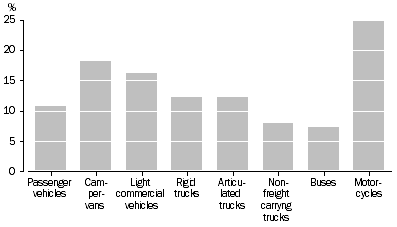
STATES AND TERRITORIES
New South Wales had the largest share of the Australian fleet with 4.3 million (29.7% of the total) registered vehicles, followed by Victoria with 3.7 million (26.1%) and Queensland with 2.9 million (20.2%). The Northern Territory had the smallest share with 0.1 million (0.8%) registered vehicles. These shares are comparable with the distribution of the population across states and territories.
From 2002 to 2006, two states experienced growth above the national average of 12.0%. The motor vehicle fleet in Queensland showed the largest growth with a 18.5% increase since 2002, an average annual growth of 4.3%. Western Australia was the other state experiencing growth above the national average, increasing 13.9% since 2002. South Australia showed the smallest growth in fleet size since 2002 (7.0%), an average annual growth of 1.7%.
Percentage Change in motor vehicle registrations - Census years 2002 and 2006
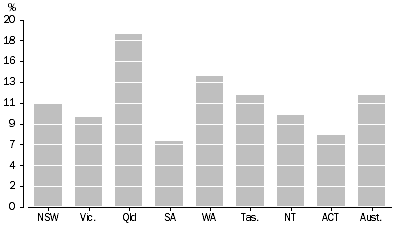
VEHICLES AND RESIDENT POPULATION
There were 699 motor vehicles per 1,000 resident population in Australia in 2006. This compares to 654 vehicles per 1,000 residents in 2002, representing an increase of 45 vehicles per 1,000 residents over this time.
Western Australia had the highest rate of all states and territories with 784 vehicles per 1,000 residents in 2006, while the Northern Territory had the lowest rate with 554 vehicles per 1,000 residents.
Motor vehicles by state/territory of registration
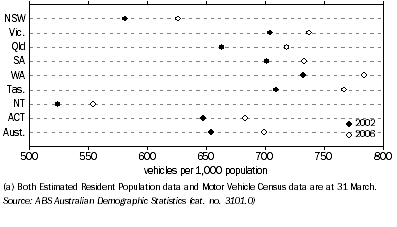
AVERAGE AGE OF THE FLEET
The average age of all vehicles registered in Australia at 31 March 2006 was 10.1 years. This is slightly younger than the 10.5 years recorded in the 2002 MVC. Vehicles manufactured before 1991 (more than 16 years old) comprised 22.9% of the total Australian fleet.
Campervans were the oldest vehicles registered with an average age of 18.9 years, while motorcycles were the youngest vehicle type with an average age of 9.4 years.
The average age of passenger vehicles dropped slightly from 10.1 years in 2002 to 9.8 years in 2006, with 21.0% of passenger vehicles manufactured before 1991.
Estimated Average Vehicle Age(a), Type of vehicle
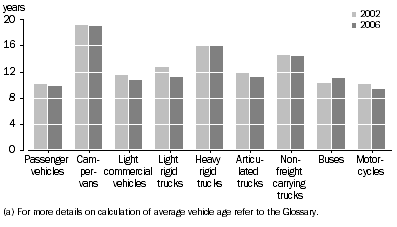
Tasmania had the oldest fleet with an average age of 12.0 years and 32.6% of vehicles manufactured before 1991. This was followed by South Australia with an average age of 11.2 years and 28.2% manufactured before 1991. Northern Territory had the youngest fleet in Australia with an average age of 9.1 years and 18.9% for vehicles manufactured before 1991.
TYPE OF FUEL
In 2006, there were 11.2 million vehicles in Australia (78.1% of the total vehicle fleet) that had been registered as using unleaded petrol, while 1.3 million vehicles (9.0%) have registered as using leaded petrol. In contrast, in 2002, there were 8.8 million vehicles (68.6%) registered as using unleaded petrol and 2.5 million vehicles (19.8%) registered as using leaded petrol. This represents an increase of 27.4% in unleaded petrol vehicles and a decrease of 49.1% in leaded petrol vehicles since 2002.
In 2006, the Australian Capital Territory had the highest proportion of vehicles (85.7%) registered as using unleaded petrol. Consistent with their older fleet, Tasmania had the highest proportion of vehicles (15.2%) registered as using leaded petrol.
Passenger vehicles comprised 86.1% of motor vehicles that were registered as using unleaded petrol and 71.4% of vehicles registered as using leaded petrol.
The number of vehicles registered as using diesel fuel made up 10.6% (or 1.5 million vehicles) of the total fleet, representing an increase of 31.8% since the 2002 MVC. Diesel vehicles were most prominent in the Northern Territory with 24.9% of the fleet registered as using this fuel type. The Australian Capital Territory had the smallest proportion of diesel vehicles with 4.4%.
Light commercial vehicles made up 41.6% of vehicles registered as using diesel fuel, while rigid and articulated trucks accounted for 22.2% and 4.6% respectively. Passenger vehicles registered as using diesel fuel increased by 42.2% since the 2002 MVC, and represented 25.4% of all diesel vehicles in 2006.
Motor vehicle fleet, Type of fuel(a)

CHARACTERISTICS OF THE FLEET
Passenger vehicles
Passenger vehicles accounted for 77.9% of all vehicles registered in Australia in 2006. The state/territory with the largest proportion of passenger vehicles was the Australian Capital Territory with 85.6%, while the Northern Territory had the smallest share with 64.3%.
All states and territories showed increases since 2002, with passenger vehicles registered in Queensland showing the largest increase (16.4%) and those registered in South Australia showing the smallest (6.1%).
A total of 6.0 million passenger vehicles were either Toyota, Holden or Ford. Respectively, these three makes accounted for 18.8%, 18.5% and 16.8% of the total passenger vehicle fleet registered at 31 March 2006.
Trucks
Rigid trucks accounted for 2.7% of all vehicles registered in Australia in 2006. The number of registrations for the heaviest rigid trucks (those with a gross vehicle mass (GVM) greater than 20 tonnes) has increased by 27.8% since 2002, while registrations for rigid trucks with a GVM of less than 20 tonnes increased only 9.4% over the same period.
Articulated trucks accounted for 0.5% of all vehicles on register in 2006. Articulated trucks with a gross combination mass (GCM) greater than 60 tonnes increased by 60.1% since 2002, while those with a GCM of up to 60 tonnes decreased in number (8.1%).
Victoria had the largest share (9,257) of articulated trucks with a GCM greater than 60 tonnes followed by Queensland with 8,775. Northern Territory had the highest percentage (78.1%) of articulated trucks with a GCM greater than 60 tonnes, compared to all articulated trucks for that state, followed by Queensland (55.5%). Queensland accounted for 59.6% of Australia's articulated truck fleet with a GCM of greater than 100 tonnes, with New South Wales the second highest at 15.1%.
Motorcycles
Motorcycles accounted for 3.2% of all vehicles registered in Australia in 2006, up slightly from 2.9% in 2002.
Australian motorcycle registrations increased 24.8% in 2006 compared with 2002. All states and territories recorded increases in registrations. Queensland recorded the largest increase of 40.5% followed by Western Australia with 28.2%. The smallest increase was recorded in Victoria (11.4%) over this time.
Motorcycle fleet, State/territory of registration
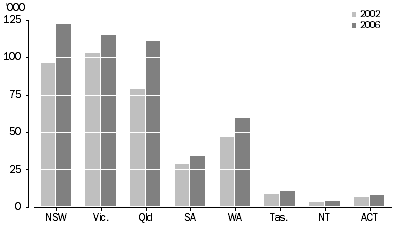
 Print Page
Print Page
 Print All
Print All